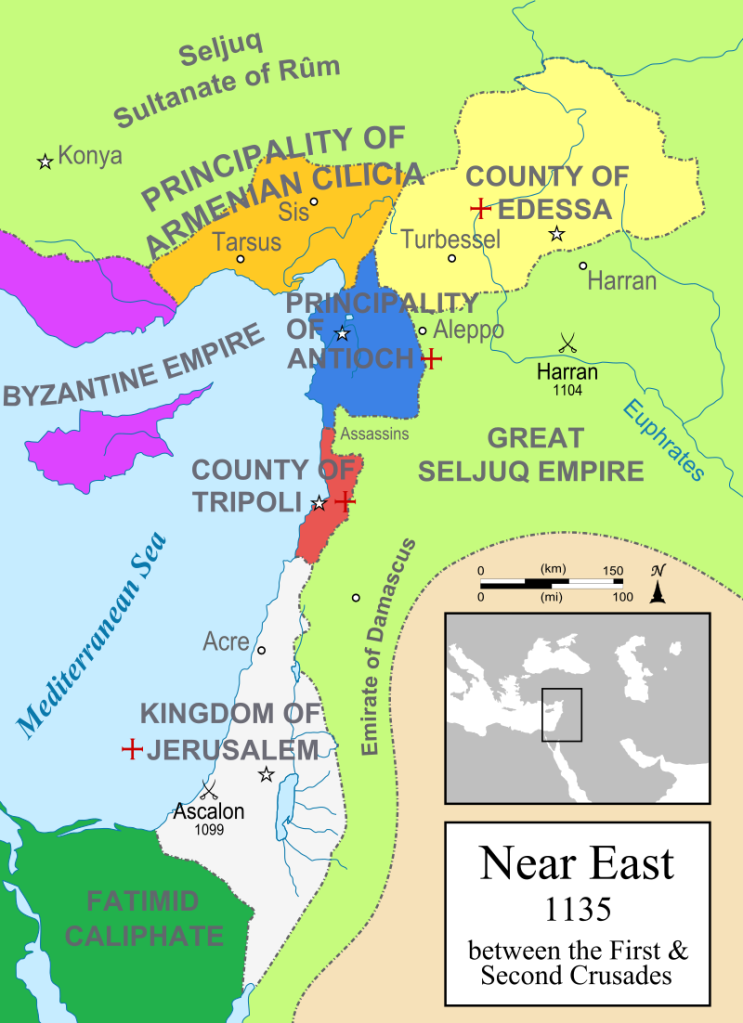
I am looking at the news this morning of the dreadful earthquake on the Turkish-Syrian border. News is flowing in of buildings collapsing like dominoes in cities of Malatya, Şanlıurfa and Gaziantep. The death toll rises by the moment.
In the Middle Ages these three towns were called Melitine, Edessa and Aintab. The region has a long history in the struggles between East and West where the borders of the Persian and Roman Empires met. The Byzantines and Sassanids prized the easily defended mountain fortresses which made any gains in the region stick.
When the First Crusade arrived in the region in 1098 the Armenian Lord Thoros of Edessa petitioned the Frankish knights to aid him in defending his Christian lands against the Seljuc Turks. Baldwin of Boulogne was the younger brother of Godfrey of Boullion who was now leader of the Crusade. Baldwin saw an opportunity to carve out an Eastern Kingdom in his own right. He took his men to Edessa and was adopted by Thoros as a son. After some political maneuvering the local nobles deposed Thoros and replace him with Baldwin, who became the first Count of Edessa. He established the first, and shortest lived of the Crusader Kingdoms.
After Godfrey passed away in 1100 Baldwin became King of Jerusalem. He turned over administration of Edessa to his cousin Baldwin of Bourcq. The fortress of Turbessel was put under the command to Joscelin of Courtenay. The region was the spear in the conflict with the Danishmends and Seljucs.
Mawdud of Mosul chipped away at the lands of the County. When Zengi united Mosul and Aleppo he was able to threaten Edessa further. In 1144 he besieged and captured Edessa. Joscelin II, son of Joscelin was left in command of Turbessel. On the death of Zengi he managed to briefly retake Edessa in 1146. But the son of Zengi was none other than the famed Nur ad-Din who captured Joscelin in 1150. Joscelin’s wife sold Turbessel to the Byzantine Emperor Manuel I Comnenus in the hope of Greek support. But within a year Nur ad-Din had conquered all the lands and the County of Edessa ceased to exist.
The fall of Edessa was used in Europe as a cause célèbre to recruit support for the second crusade. It was Nur ad-Din who had the dream of uniting the Muslim forces between Mesopotamia and the Nile to drive the Franks out of the Middle East. He did not realize his dream, but passed it on to his son, and his lieutenant, Saladin.
Today on the Syrian side of the border the land is a conflict zone. In 2013 the Islamic State (ISIS or ISIL) made its power base centered on Mosul in Iraq and Raqqa in Syria. Abu Bakr al Baghdadi announced his goal to establish a state from Aleppo in Syria to Diyala in Iraq.
President Assad of Syria was already fighting internal unrest sparked by the American backed “Arab Spring” rebellions across North Africa and the Middle East. Assad supported by Russia found himself in a proxy war between Russia and the USA.
Turkey and Iran are providing their own support to various factions of breakaway Syrian military units. There are so many Syrian Interim, Provisional and Salvation Governments that it reads like the Monty Python “Peoples front of Judea” scene from the Life of Brian. Meanwhile the Kurds are always open to the possibility of establishing their own independent nation.
For the Turks the Earthquake today is bad enough. As the map of various military factions below shows; the Syrian region is in the front lines of the Syrian Civil War. The earthquake is a far greater disaster in a region where the civil authorities are limited or non-existent and access to the earthquake zones may be a challenge.
Since I began writing this article the reported death toll has risen from 600 to 1,600. It is expected to rise.

-=o0o=-
This site is available for free and I make no money from any ads you see here. If you would like to show your appreciation feel free to leave a comment or you can buy me a coffee! http://buymeacoffee.com/DonalClancy